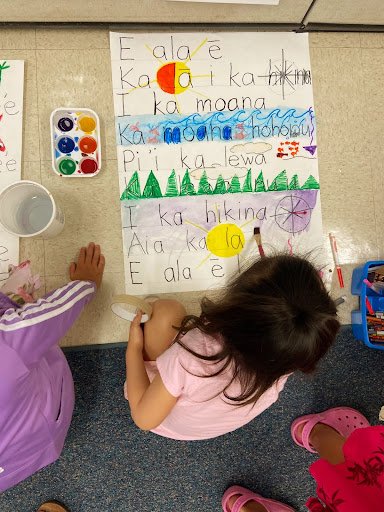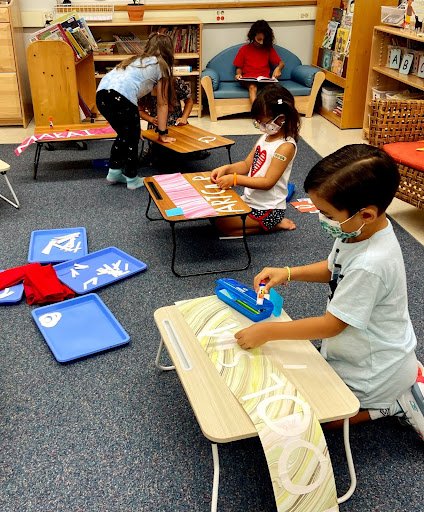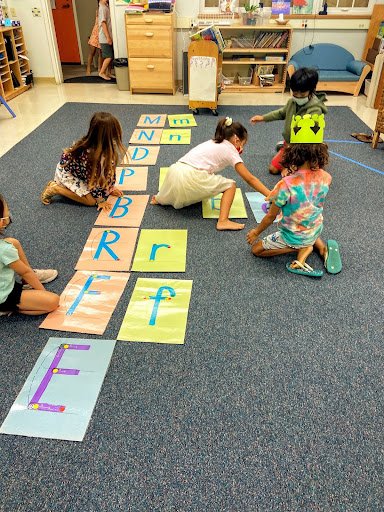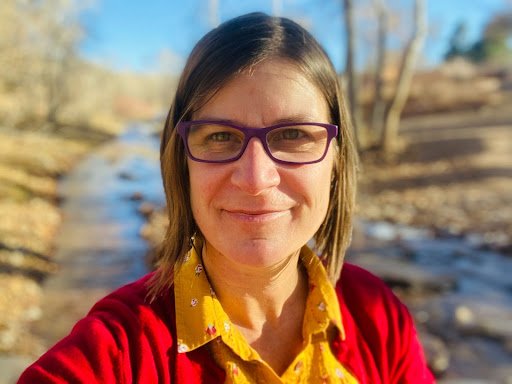By Kristin Baker
Teaching is a life project, a calling, a vocation
that is an organizing center of all other activities….
Teaching is pain and humor,
joy and anger,
dreariness and epiphany.
Teaching is world building,
it is architecture and design,
it is purpose and moral enterprise.
Teaching is a way of being in the world that breaks through the boundaries …
and in the process
redefines all life
and teaching itself.
-Ayers, 1989, p. 130 as quoted by Dana & Yendol-Hoppey, 2014
Teaching is an incredibly complex and dynamic endeavor. Teachers must navigate a complicated web of critical relationships on a daily basis and work together to guide learners through a changing landscape that includes aspects of multiple fields of knowledge. A teacher’s work is influenced by small and large–personal and societal–shifts in the outside world that inevitably make their way into the classroom, sometimes explicitly, other times on the soles of their students’ shoes. Teaching is both an art and a messy science, one that cannot be realistically limited to a single variable.
In this blog, the first in a two-part series, I reflect on my experience as a Teacher Scholar at Hanahau‘oli School during the 2021-22 school year. I explain why teacher research is critical to the profession and how I stepped into the Teacher Scholar role at Hanahau‘oli. I also introduce an example of a problem I identified within my teaching practice and how the Teacher Scholar role at Hanahau‘oli School offered me time and space away from the classroom to develop a line of inquiry to address the challenge. In a second blog to follow, I will elaborate on the experimental strategies I tested to address the problem, what I learned from my investigation, and reflections on how this learning will impact my teaching practice moving forward.
Defining Teacher Research and Its Purpose
The expertise and voices of teachers is painfully absent and undervalued in our education system as a whole, though it has long been central to the development of progressive philosophy and pedagogy, famously within John Dewey’s Laboratory Schools and in a less-publicized way within hundreds of other progressive schools over the past century or so. By creating time and space for teachers to engage in ground-level research, problem-solving, development of curriculum, and stronger teaching practices within their own classrooms, we empower teachers–the leading experts in the areas of teaching and learning–to work out viable solutions for specific problems we face within our teaching contexts, and provide ground-level insight as we chip away at some of the more complex dynamics teachers face in the classroom everyday.
In the Reflective Educator’s Guide to Classroom Research (3rd Ed.), Dana and Yendol-Hoppey gather multiple definitions of teacher research and descriptions of the teacher inquiry process. Teacher-research is “...a vehicle that can be used by teachers to untangle some of the complexities that occur in the profession” (Dana & Yendol-Hoppey, 2014, p. 6). It is effective and directly applicable within the classroom because “theories and knowledge are generated from research grounded in the realities of educational practice, teachers become collaborators in educational research by investigating their own problems, and teachers play a part in the research practice, which makes them more likely to facilitate change based on the knowledge they create” (Carr & Kemmis, 1986 as cited in Dana & Yendol-Hoppey, 2014, p.8).
The teacher inquiry process can be defined as an on-going spiral of observation, reflection, and action that includes:
1) clarifying and diagnosing a practical situation that needs to be improved;
2) formulating action strategies to improve the situation or solve the problem;
3) implementing the action strategies and evaluating their effectiveness;
4) clarifying the situation, resulting in new definitions of problems or areas for improvement, and so on, to the next spiral of reflection and action. (Elliot, 1998 as cited in Dana & Yendol-Hoppey, 2014, p. 8)
Effective educators engage in this process informally all the time. By taking extra steps to explicitly document and collaborate with others during the inquiry process, reflection delves deeper, action becomes more likely, and teaching becomes more innovative and well developed with illustrations for others to understand and possibly borrow. Teacher-researchers or teacher-scientists, working in a professional community of inquiry, come to see that learning and teaching are reciprocal processes. They come to see themselves as teacher scholars.
Learning About the Teacher Scholar Role at Hanahau‘oli School
Over the years, by studying and learning from young children in the elementary classroom setting, I have discovered many facets of their incredible powers to learn. These insights inform my teaching practice, inspire me to create and evolve tools for learning in the classroom, and help me grow my expertise as an educator. Though I have carried this spirit of inquiry throughout two decades of learning to teach (primarily by teaching in elementary and middle grades classrooms), only within the past few years have I come to identify as a teacher-scientist, teacher-researcher, or teacher scholar. Two experiences have supported me as I step into this new identity: my final research project as a graduate student in literacy education at Loyola University Maryland and my experience as a Teacher Scholar on the faculty at Hanahau‘oli School.
I first discovered the power of teacher inquiry as a graduate student and literacy education scholar. Under the guidance of my graduate school instructor, and in collaboration with a peer cohort of teacher-students, I dove deep into a line of inquiry centered around the question: What does social justice curriculum look like in a first grade classroom? I was responding to the challenge of articulating how issues of social justice and fairness arise in the early elementary classroom and how I have developed curriculum and learning experiences that guide some of the youngest learners to explore issues of fairness and power. This line of inquiry led to a critical literacy curriculum mapping project within my first grade classroom.
As I was interviewing to join the faculty at Hanahau‘oli School in the spring of 2021, I remember feeling especially drawn to Head of School Lia Woo’s vision: “faculty will learn from teaching instead of for teaching.” She connected her vision with Darling-Hammond, “viewing teaching as a process of ongoing investigation … integral to … the goal [of] lifelong ability to learn … rather than short term learning for teaching” (Darling-Hammond, 2014 as quoted in Woo, 2021). “In short, teachers will be ‘students of little children’ (Sprague Mitchell, 1987, p. 290 as quoted in Woo). Woo (2021) went on to write: “Within the living laboratory all community members (children and adults) should feel empowered to pursue their curiosities and interests…appreciate the arts as … integral and essential …be familiar with change as a constant…embrace diversity …. draw upon one’s strength and courage to critically question, creatively problem-solve and clearly communicate in the pursuit of one’s goals.”
I wanted to be a part of this. I was thrilled to find a community of educators at an elementary school in the middle of the Pacific Ocean who spoke the same progressive education dialect I spoke. I jumped at the opportunity to become a long-term substitute teacher and Teacher Scholar at Hanahau‘oli School during the 21-22 school year.
Observation & Seeds for Inquiry
I launched the 21-22 school year as a long-term substitute teacher in a mixed age K-1 classroom with 12 students, and spent the first four months of the school year teaching and learning with them. We made the Language Lab our home–a space originally designed for second language classes, borrowed in COVID years as a homeroom space. It was in this classroom that I found one particular spark for inquiry; her name is Aly. When I met Aly, she was 2 months past her 5th birthday.
It didn’t take long to get to know Aly. She is super-friendly and easy to talk to. She makes deliberate and interesting fashion and accessory choices that are ripe for appreciation, and speaks often of her love for her 2-year old sister, family, sea life, Minecraft, and her desire to make new friends. She gravitates toward building projects and crafting with mixed media.
One morning during work time, she saw me quickly lettering a poster. I often letter classroom posters in pencil and ask children, especially those who can use additional practice with letter formation, to help “make the letters pop” by tracing the letters with a marker–this creates an opportunity to practice writing letters within an authentic context and also opens the door for one-on-one guided letter-writing practice that can be quite challenging to get enough of in the classroom setting. As a child is tracing the letters on the poster, I am able to observe the child’s habits (where they start a letter, how they connect the strokes), assessing what awarenesses and skills they have when it comes to forming letters, and using verbal prompting or modeling as needed to help the child learn more efficient habits. In contrast to a more traditional approach to practicing letter-formation (writing a single-letter repeatedly in a much more fabricated context, like a worksheet or workbook), lettering a poster allows for “learning by doing”–a child practices the skill of letter formation while creating a real tool for the class. In this case, we were making a poster with the words to a Hawaiian song we were learning for the upcoming Makahiki ceremony. Co-creating posters with my young students in this way is a recent discovery in my teaching practice; this technique has become part of my menu of approaches for guiding children toward efficient habits and techniques for writing their letters.
As Aly observed me lettering in pencil, she complimented: “Wow, you’re really good at making letters.” “Thanks,” I responded, “I’ve been practicing ever since I was 5. It can be tricky to form letters at first, but it becomes automatic after a while.” I went on to share that I would love to show her how I do it. Handwriting is still quite challenging for Aly, and I was hoping to leverage this moment of interest and curiosity to engage her in some skill-building instruction and practice.
In general, handwriting is a tricky skill to teach for several reasons. The first is an issue of human resources: one of me, lots of them. Effective guided practice, especially for the children for whom the task is challenging, takes a lot of one-on-one reminders and redirection. Children have often been picking up writing tools for years before they step into the classroom, and their younger selves can develop not-so-efficient habits for holding a pencil and forming letters that need to be polished as their expectations for writing grow. Another challenge is that children’s developmental timelines vary greatly. Whole-group instruction rarely meets everyone’s needs: some children need time for fine motor muscle development, some need very little instruction and pick up great handwriting habits on their own (or from someone outside of the classroom). A third challenge is my opinion (and I’ve read this on the faces of children, too) that handwriting practice can be kind of boring and disconnected from real life applications, especially when presented as a long series of steps to be memorized in order to get from writing A to Z. I have been battling all of these challenges with creativity over my years in the early elementary classroom.
To elaborate on the ways in which I teach handwriting to young children, this photo gallery illustrates some of the approaches I currently use to teach and guide letter formation.
We start the year making the letters of our initials and names using only four simple shapes: big line, little line, big curve, little curve. This activity was adapted from a concept I learned from the Handwriting Without Tears program.
We continue to construct letters from big/little lines and curves in order to make signs to label different areas of our classroom. We discover that every lowercase and uppercase letter in the alphabet can be built from these four simple shapes!
We trace giant letter maps with our fingers, paying close attention to the place the letters start (marked with a green dot).
Children also have traditional handwriting worksheets in their skills folders that they work through independently to practice repeated writing of individual letters as part of their morning jobs.
Throughout my time as a first grade teacher, I have questioned whether this evolving series of handwriting activities is effective in teaching 6 and 7 year olds correct letter formation. And now, with 5 year olds like Aly in my classroom, more questions arise: What should I realistically expect in terms of handwriting from a beginning of year kindergartener (vs. a beginning of year first grader, for whom my expectations are more clear, having spent quite a bit of time in first grade)? How do I need to modify the activities I use to teach and guide letter formation practice in my classroom to meet the needs of each student when it comes to handwriting? A seed for inquiry was planted.
Stepping into the Teacher Scholar Role
At the time that this problem of practice emerged, the first semester of the 21-22 school year was wrapping up and I was preparing to step into my role as a Hanahau‘oli School Teacher Scholar.
Simply put, Teacher-Scholars are faculty who actively engage with research in their respective fields of study, and through that, provide unique benefits to their students. These benefits include joint research opportunities, cutting-edge relevancy, increased opportunity to build strong mentor-relationships with [other] faculty, and most importantly, the chance to explore their own creativity within their field of study (Rogerson, 2018).
At Hanahau‘oli the Teacher Scholar position built off of this definition and included: collaborating with school leadership to identify and refine lines of inquiry, scholarship, research, and writing; working with classroom teachers to articulate and document curriculum; organizing existing scholarship and research at the school; communicating learning through various outlets; and spending time with other visiting scholars. The Teacher Scholar role also included supporting other teachers in their professional lines of inquiry and development as progressive educators, and collaborating with interested students on research, writing and publishing. Finally, this new role offered me time and space away from my teaching practice to develop my recently identified personal line of inquiry–a study about teaching handwriting in the elementary school classroom.
Inspired to develop a more constructivist approach to handwriting that leverages young learners’ affinity for art and exploration, I jumped into my role as Hanahau‘oli School Teacher Scholar in January 2022 and began designing a series of handwriting workshops to experiment with this new approach. In Part 2 of this blog post, I look forward to sharing with you the story of the teaching experiment and accompanying research project I designed. Additional questions that emerged throughout the journey, reflections on my learning, and a summary of how this semester-long experience as a Hanahau‘oli Teacher Scholar will inform my teaching practice moving forward await. In taking you along on this journey, I hope that you too will benefit from my year, in Lucy Sprague Mitchell’s words, as a student of little children.
Works Cited:
Ayers, W. (1989). The good preschool teacher: Six teachers reflect on their lives. New York: Teachers College Press.
Dana, N.F. & Yendol-Hoppey, D. (2014). The reflective educator’s guide to classroom research: Learning to teach and teaching to learn through practitioner Inquiry (3rd ed.). Thousand Oaks, CA: Corwin, A SAGE Company.
Rogerson, J. (2018, September, 6). Teacher-Scholar Model: Integral to Preparing Students for Success in a Changing World. University of Arkansas Little Rock Office of Alumni and Development. https://ualr.edu/development/2018/09/06/teacher-scholar-model-integral-to-preparing-students-for-success-in-a-changing-world/#:~:text=Simply%20put%2C%20Teacher%2DScholars%20are,unique%20benefits%20to%20their%20students.
Woo, L. (2021).Vision for Hanahau‘oli School.
ABOUT THE AUTHOR:
Kristin Baker is a teacher, parent, scientist, literacy scholar, writer, activist, artist, athlete, and language-learner. She has spent the bulk of her 19 year teaching career working with lower elementary students at two independent, progressive elementary schools, one on each coast of the continental United States. Kristin holds a Bachelor of Science in Molecular and Cell Biology from U.C. Berkeley and a Masters of Education in Literacy from Loyola University Maryland. She is currently working as a Teacher Scholar on the faculty at Hanahau‘oli School in Honolulu, Hawai‘i.









